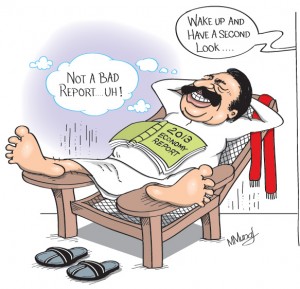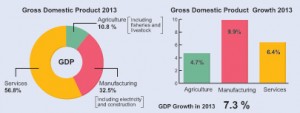Columns
Economic performance in 2013 and growth prospects
View(s):The spurt of growth in the third quarter of the year — 8.2 per cent — contributed to an economic growth of 7.3 per cent in 2013 and it was significant.
 The growth in industry by 9.9 per cent with factory industry growing by 12.1 per cent and textiles and apparels growing by 15.3 per cent in the last quarter portend well for this year’s economic growth. These achievements give rise to expectations of a continued growth momentum in 2014, especially as export manufactures have recovered and expanded. Longer-term growth is, however, dependent on economic stability, reforms and an environment conducive to investmen
The growth in industry by 9.9 per cent with factory industry growing by 12.1 per cent and textiles and apparels growing by 15.3 per cent in the last quarter portend well for this year’s economic growth. These achievements give rise to expectations of a continued growth momentum in 2014, especially as export manufactures have recovered and expanded. Longer-term growth is, however, dependent on economic stability, reforms and an environment conducive to investmen
Economic growth in 2013-14
Last year’s economic growth was one percentage point above the previous year’s growth of 6.3 percent, though much lower than in the two years immediately after the war. While manufacturing is likely to grow, agricultural output is likely to decline this year. The growth in export industry is likely to contribute to higher growth in manufacturing and services as in 2013. An economic growth of around 7 per cent is not unrealistic to expect this year.
Agriculture
The GDP estimates by the Department of Census and Statistics indicate a growth of 4.7 per cent in agriculture. This is less than the 2012 growth of 5.2 percent. This was despite a 3.6 per cent increase in tea production that resulted in a record tea crop of 324 million kilograms and an increase in paddy production. This lower growth in agriculture was due to contracting of rubber and coconut production by as much as 9.1 per cent and 16.1 per cent, respectively. Although drought conditions are likely to affect most agricultural crops adversely this year, it will not reduce GDP much because agriculture contributes less than 11 per cent to GDP.
 Industries
Industries
Industrial growth of 9.9 per cent with a higher last quarter growth of nearly 12 per cent is a hopeful sign. The spurt in growth of textile and apparels in the fourth quarter led to an 8.9 percent growth in 2013, much higher than the 4.9 per cent in 2012 and this gives hopes of a resuscitation of the garment export sector this year.
Services
Services that contribute 56.8 per cent to GDP grew by 6.4 per cent compared with 4.6 per cent in 2012. Increase in trade contributed much to this growth with export trade growing at 6.7 per cent and internal trade by 6.9 per cent. Transport and communication grew by 9.4 per cent with post and telecommunications that have been dynamic in recent years growing by 11.4 per cent. The growth in tourism is mainly responsible for hotel and restaurants growing by 7.1 per cent. Services are likely to grow this year too.
Growth prospects
The higher growth in the fourth quarter of last year is a positive sign, especially as there was a significant increase in manufactures, with textile and garments exports being the largest contributor to this growth. The growth in industrial exports that spurred the increase in manufacturing underscores the importance of exports for the country’s economy. While fluctuations in global demand for our manufactures is inevitable, maintaining competitiveness and good trading relations with countries that matter for our trade is important. The management of the exchange rate that ensures competitiveness of manufacturing exports can hardly be over emphasised.
In the long run, there should be an eye on the diversification of manufactured exports and export markets. Both these goals are not necessarily easy to achieve as to suggest. An enabling climate for new enterprises and conditions conducive to attracting foreign direct investment into export industries are prerequisites for longer-term export growth. The tardy inflow of FDI into export industry has been a constraining factor in reducing our share in world exports.
Agricultural growth
Agricultural growth is by its very nature subject to the vicissitudes of the weather. Notwithstanding these fluctuations in output due to climatic factors, there are serious constraints to production of tea, the country’s main agricultural export. The senility of plants in the plantations and the need for much more extensive replanting, problems of securing fertiliser and labour shortages are a threat to increasing tea exports. Despite the Government’s rhetoric of emphasising the importance of agriculture, it remains a neglected one with little potential for growth due to inadequate investment in research and extension.
There is a need to look at ways and means of increasing agricultural production by expanding and diversification of crop production for both export and import substitution. The need to devise new modes of production on larger scales and more scientific technology are prerequisites for a new thrust in increasing agricultural output. The release of government land is vital to enhance such agricultural growth. Although agriculture including fisheries contributed only 10.8 per cent of GDP last year and its proportion in GDP is likely to decline owing to the expansion of other sectors, agricultural output should grow in tandem with this declining proportion in GDP.
Fisheries
The improved performance in fisheries in recent years has been mainly due to the resuscitation of the industry owing to increased areas for fishing rather than increases in production capacity and productivity in fisheries. The current problems of fishermen in increased costs of their inputs and other problems need to be addressed. An island nation still remaining a net importer of fish in spite of a large 200 mile ocean rights is indicative of economic incapacity.
Summing up
The economic performance of last year, especially growth in the last quarter, portends possibilities of higher growth this year. However, much of the potential for high long-run growth has been compromised by imprudent expenditures, lack of proper priorities and inefficiencies. The high current growth should not blind us to serious weakness in productivity and the need for policies that enhance production and productivity. Much of the higher growth potential even in agriculture still remains untapped. Good economic management, the improvement of the investment climate and attraction of FDI for export industry are vital for a leap in economic growth.


